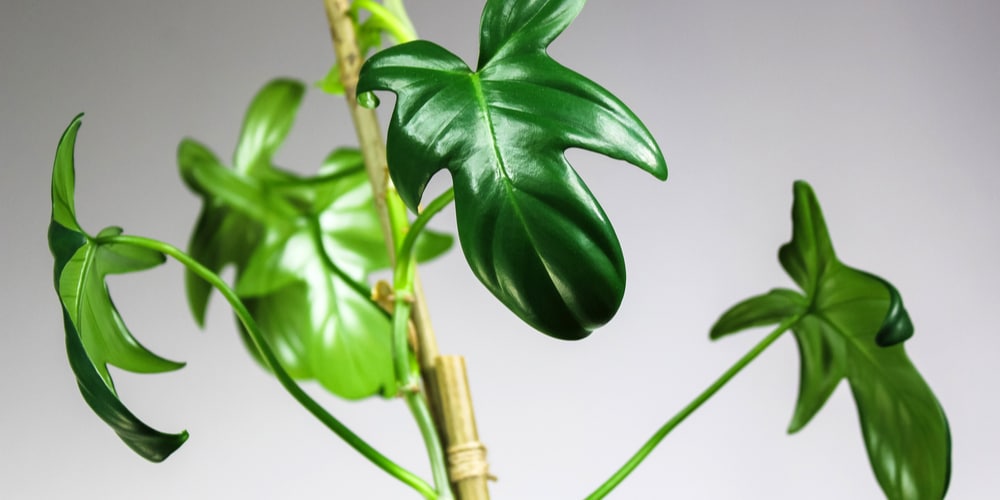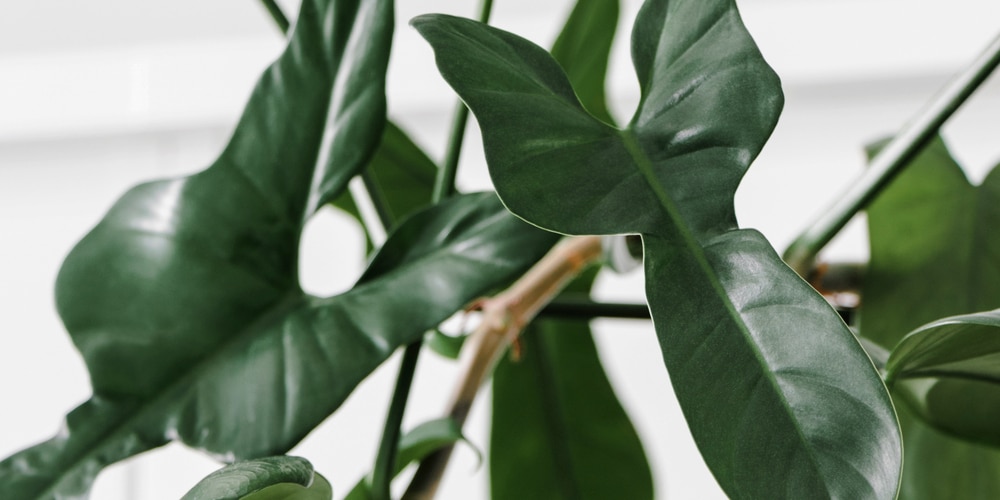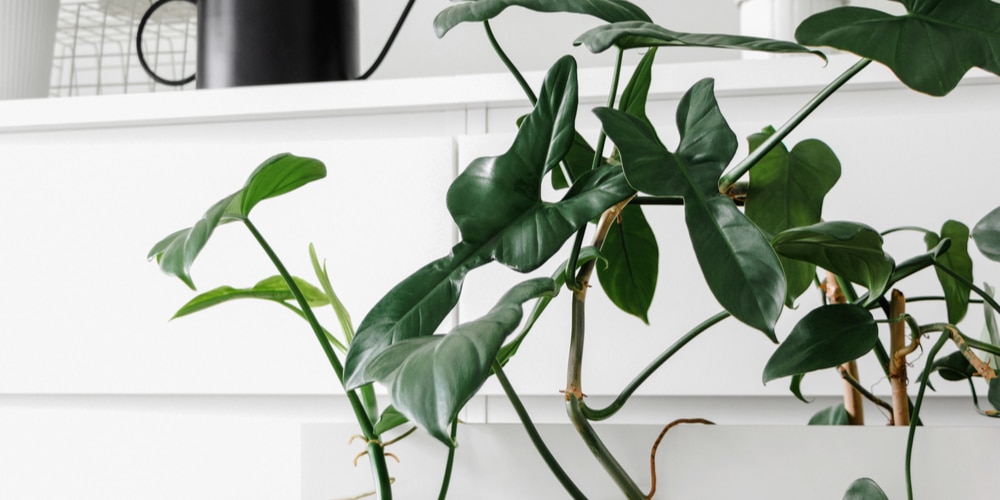The Philodendron bipennifolium is a large plant that originates from South America. It’s commonly found growing in the Brazilian rainforests as well as Bolivia, Argentina, and Paraguay. Nowadays, this plant has adapted to cooler regions and is commonly grown outside in warmer areas of the US. It’s also kept as a houseplant worldwide.
The Philodendron bipennifolium has large leaves with lobes. These plants are fast-growing and can reach a height of 5 to 7 feet with the correct care. In tropical regions, the plants get a lot larger. If you decide to grow a Philodendron bipennifolium as a house plant, you can control its size with regular pruning. Let’s look at how to grow and care for a Philodendron bipennifolium plant.
What Is Philodendron Bipennifolium?

The Philodendron bipennifolium is an evergreen plant that goes by the names of Lacy Tree Philodendron and Horsehead Philodendron. It’s an epiphyte rainforest plant that depends on larger trees for support. It’s said that the plants’ foliage looks like the shape of a horse’s head. These fast-growing plants will attach their vines to fences, trees, and other plants. When keeping a Philodendron bipennifolium as a houseplant, you can use a moss pole that your plant will climb.
Philodendron bipennifolium spread quickly in the right climate. They can be grown outdoors in USDA zones 9 to 11. Don’t leave philodendrons outside in cooler temperatures as they aren’t very cold tolerant and can be affected by frost and drafts.
Philodendron bipennifolium has a beautiful appearance and can purify the air, which adds to their popularity. These plants are toxic to humans and animals if ingested.
Philodendron Bipennifolium Care Tips
Philodendron bipennifolium is part of the Araceae family and requires very similar care as other philodendron varieties. They are generally considered a relatively easy variety of tropical plants to care for. Here are some tips to help you grow a thriving Philodendron bipennifolium plant:
Philodendron bipennifolium Sunlight Needs
Philodendron bipennifolium prefers to grow in light that’s bright and indirect. They can also thrive in partially shaded areas. These plants are pretty sensitive, especially when juvenile, and can become easily burnt by the sun. Be careful not to leave your plant in the full sun as burnt leaves will become scarred and will never fully recover.
When choosing a place to plant your Philodendron bipennifolium, aim to mimic a rainforest environment. In the wild, Philodendron bipennifolium will be shaded by taller plants but will still get some sun. They will also be growing in a hot and humid environment.
Many gardeners choose to grow their Philodendron bipennifolium underneath a tree in their yard. Plants usually do well in such spots, but you should remember that the Philodendron bipennifolium is a climber that will attach itself to a tree as it grows.
Philodendron bipennifolium Watering Requirements
Philodendron bipennifolium should be watered regularly and should only be watered once the topsoil has dried out. Aim to keep the soil moist rather than damp or completely dried out. Always test your plant’s soil with your finger before watering to avoid overwatering.
Over-watering happens when the soil becomes waterlogged, and this will cause root rot. Root rot is a fungal infection that can kill the philodendron bipennifolium plant. Waterlogged soil makes it hard for plants to absorb the oxygen and nutrients they need. Too much water may discolor your plant’s foliage and attract pests.
In the late fall and during the winter, you can reduce watering. Your plant’s soil will be able to retain water for longer during the colder months.
Philodendron bipennifolium: Soil
Philodendron bipennifolium requires soil that’s rich in nutrients, loose, and well-draining. Poor drainage will lead to the earth becoming waterlogged, which can cause root rot. Ensure your plant has good drainage by planting it in a pot with drainage holes. You can also add some gravel or stones to the bottom of the pot. This will help excess water to drain away.
Loamy soil is best for philodendrons and many other tropical houseplants. You can use a tropical house plant pre-mix or make your own soil using compost, perlite, peat moss, and sand. Philodendron bipennifolium thrives when grown in soil with a pH of between 5 and 6.
Philodendron bipennifolium temperature needs
Philodendron bipennifolium likes warm environments and grows best when the temperature is between 65 and 70 F. Nighttime temperatures can be slightly lower, but your plant won’t survive if there’s frost on the ground. It’s recommended that you don’t leave your plant outside if the temperatures are expected to drop to below 55F.
Philodendron bipennifolium humidity needs
Philodendron bipennifolium plants love humidity as they are native to the Brazilian rainforests. You can increase humidity by placing a tray with water and pebbles underneath your plants. This will provide the foliage with moisture as the water evaporates. Alternatively, group tropical plants together and spray with a fine mist daily. Be careful not to soak your plant’s leaves as over misting can cause fungal infections.
Fertilization
Fertilizing Philodendron can be fertilized two or three times during the growing season. You can either use a slow-release fertilizer or a liquid fertilizer formulated for tropical plants.
Always use a good quality fertilizer and apply it to moist soil to avoid chemically burning the roots. Be careful not to use a fertilizer that has a high salt content as these will contaminate the soil and will harm your plant.
Pests
Philodendrons are generally relatively pest-resistant but can sometimes be affected by sap-sucking insects. Aphids, mealybugs, and spider mites can infest Philodendron bipennifolium plants. If you notice any signs of insects, you can shower them off your plant. When an infestation occurs, you’ll need to use an insecticidal spray or neem oil to kill the pests.
Conclusion
The Philodendron bipennifolium is a lovely tropical plant that’s unique and will look great in any home or office environment. These plants can also be grown outdoors in the right climate, and their trailing vines look great when planted in a hanging basket.
Philodendron bipennifolium is easy to grow and perfect for beginners. These plants are fast-growing and will thrive if you get the watering requirements, sunlight, temperature, and humidity right.

